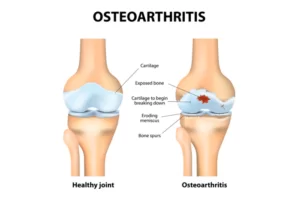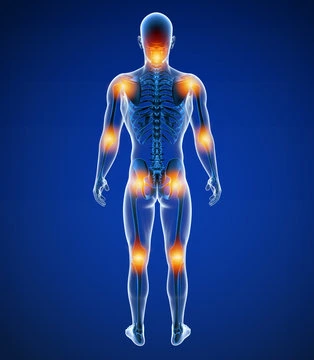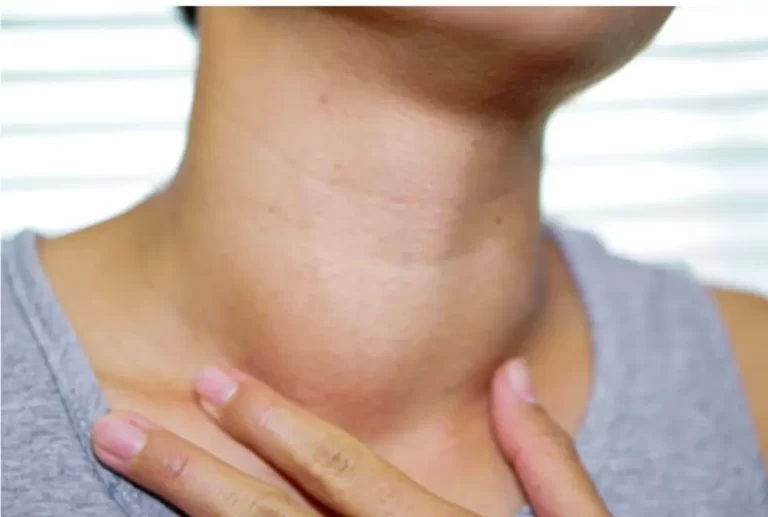Subscapularis Muscle Pain
The subscapularis is one of the four muscles of the rotator cuff, located on the front of the shoulder blade (scapula). It plays a key role in shoulder movement, particularly internal rotation and stabilization of the joint.
Pain in the subscapularis can result from overuse, poor posture, repetitive movements, or acute injury, such as a strain or tear. Common symptoms include deep shoulder discomfort, reduced range of motion, and difficulty reaching behind the back.
Treatment often involves rest, stretching, strengthening exercises, massage, and, in severe cases, physical therapy or medical intervention.
What is Subscapularis Muscle Pain?
- The term “subscapularis muscle pain” describes any discomfort or soreness from the subscapularis muscle, one of the shoulder’s four rotator cuff muscles.
- Located on the shoulder blade’s front (anterior) surface, or scapula, this muscle is essential for the stability and internal rotation of the shoulder joint.
- Shoulder pain and dysfunction may result from irritation, straining, or injury to the subscapularis.
what is the subscapularis muscle?
- One of the four rotator cuff muscles in the shoulder is the subscapularis muscle. It is essential for shoulder stability and movement.
- the largest and strongest rotator cuff muscle, according to anatomy, is the subscapularis, which is located on the anterior (front) surface of the scapula, or shoulder blade.
Anatomy
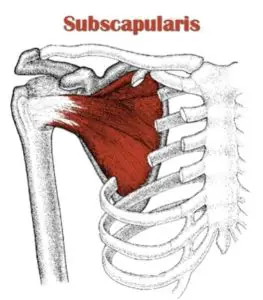
Origin:
- On the scapula’s front (front) side, the subscapularis muscle starts at the subscapular fossa, a large concave area.
Insertion:
- After that, it travels laterally and attaches to the humerus’s lesser tuberosity, a bony protuberance on the upper arm bone.
Nerve supply
- The brachial plexus’s branches, the upper and lower subscapular nerves, innervate the muscle.
Function:
- The turning of the arm inside toward the body, or internal rotation, is the main function of the subscapularis.
- When the arm is in specific postures, it helps with shoulder joint extension and adduction, or bringing the arm toward the body.
- The muscle is essential for shoulder stability because it keeps the humerus’ head in the scapula’s narrow glenoid cavity.
Common Causes of Subscapularis Muscle Pain:
- Overuse or muscular Strain: Microtears, strains in the subscapularis, and muscle fatigue can result from repetitive overhead activity like lifting, throwing, or swimming. These stresses may hurt to stretch or contract the affected music
- The subscapularis, a component of the rotator cuff, is susceptible to injury, just like the other rotator cuff muscles, especially in elderly adults or people with poor shoulder mechanics. Although they are less frequent than tears in other rotator cuff muscles, subscapularis tears can cause pain, weakness, and restricted movement.
- Tendinitis or Tendinopathy: Pain, particularly when performing shoulder movements like internal rotation or lifting, can result from inflammation or degeneration of the tendon of the subscapularis muscle.
- Shoulder Instability: Shoulder instability can result from weakness or dysfunction in the subscapularis, which can cause pain when moved in specific positions or under stress.
- Impingement Syndrome: When the acromion (a portion of the shoulder blade) and the head of the humerus (upper arm bone) compress against one another, the subscapularis tendon may become inflamed. Pain in the front of the shoulder may arise from this, particularly while moving overhead.
- Bursitis: Pain from inflammation of the subacromial bursa, a fluid-filled sac next to the rotator cuff, may travel to the subscapularis, which is located in the front of the shoulder.
- Problems with posture: The subscapularis muscle can become overstretched, tight, and uncomfortable due to poor posture, particularly rounded shoulders or forward head posture.
Symptoms of Subscapularis Muscle Pain:
- Deep, throbbing pain could worsen when lifting, reaching, or doing overhead movements.
- shoulder weakness, especially during inward arm rotation or when doing strength-demanding work.
- discomfort when the arm is raised or extended behind your restricted range of motion because of shoulder stiffness or discomfort.
- tenderness in the subscapularis area or while applying pressure to the front of the shoulder
Risk factors
- Subscapularis muscle soreness and other shoulder-related problems can be more likely to occur in those who have certain risk factors.
- Age: Degenerative Changes: The muscles, ligaments, and tendons surrounding the shoulder degenerate with age
- Tendonitis, tendinopathy, or rotator cuff tears—conditions that may affect the subscapularis muscle—can result from this. The rotator cuff tendons lose strength and elasticity with age, making people more prone to injury.
- Reduced Healing Capacity: Chronic pain and dysfunction may result from older persons’ slower healing from injuries.
Overhead Repetitive Tasks:
- Sports and Physical Activities: Swimming, throwing (baseball, tennis), weightlifting, and racquet sports are examples of activities that can cause tension in the subscapularis muscle since they require repetitive overhead motions.
- These activities frequently include internal rotation of the shoulder, which makes this muscle more active
- Risks Associated with the Occupation: The subscapularis tendon may be overworked and irritated or injured in occupations that include a lot of overhead movements, such as carpentry, painting, and building.
- Rounded Shoulders: Unbalances in the muscles surrounding the shoulder girdle can result from poor posture, including rounded shoulders, frequently linked to hunching forward or sitting at computers.
- The subscapularis muscle and its tendon may be further strained due to abnormal movement patterns.
Muscle Imbalance:
- Weak Rotator Cuff or Scapular Muscles: The subscapularis muscle may be overused as a compensation mechanism if the muscles around the shoulder, such as the rotator cuff, trapezius, and serratus anterior, are weak or unreliable.
Strength Training Overhead Without Correct Form:
- Improper Lifting Techniques: Lifting large weights overhead or engaging in shoulder-stressing exercises (such as snatches, chest presses, or overhead presses) without the right form or warm-up can lead to subscapularis muscle strains or overuse injuries.
- Absence of Warm-Up: The risk of injury can be increased by not adequately warming up before shoulder-intensive exercises.
Diagnosis
- To identify the cause of the pain and rule out other potential causes, medical professionals usually use imaging scans, clinical examinations, and occasionally functional testing when diagnosing subscapularis muscle pain.
- An outline of the typical diagnostic methods for subscapularis discomfort is provided below:
Medical History and Clinical Examination:
- Level of activity and past injury history: if the discomfort has a connection to a particular incident (such as a fall, trauma, or prolonged overhead activity).
- The features of pain: The location, severity, and length of the discomfort, together with any radiating pain (down the arm, for example).
- Prior shoulder injuries: Dislocations, impingement, or rips in the rotator cuff are examples of past shoulder issues.
physical assessment
- To examine for soreness or swelling, the physician will palpate, or feel, the front of the shoulder, paying particular attention to the subscapularis tendon.
- Range of motion: The examiner will evaluate the active and passive ranges of motion of the shoulder. Limitations may indicate subscapularis involvement, particularly when internal rotation is present.
- Strength testing: Specific strength tests will be conducted to evaluate the function of the rotator cuff muscles, including the subscapularis.
- Special rotator cuff tests: Several tests can be utilized to isolate the subscapularis muscle and assess for dysfunction or injuries.
The Subscapularis Involvement Special test
belly press test:
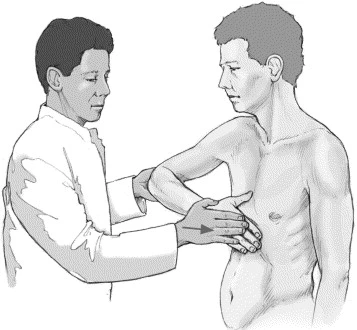
- take sitting or standing
- Position of the arms: The patient’s elbow is 90 degrees bent, palm up.
- Position of the hand: The patient’s hand is positioned on the upper abdomen, directly beneath the bony point at the base of the sternum, known as the xiphoid process.
- Movement: The patient is instructed to internally rotate their shoulder by pressing their palm on their abdomen.
A positive test result:
- The movement causes pain for the patient.
- Because of weakness, the patient’s elbow falls behind their trunk and they cannot hold the position.
- The patient uses other muscles, like the rotator cuff or biceps, to help with the movement and compensate for the deficiency.
lift-off test
- The subscapularis muscle, one of the shoulder’s rotator cuff muscles, is evaluated for function using the lift-off test, also called Gerber’s lift-off test.
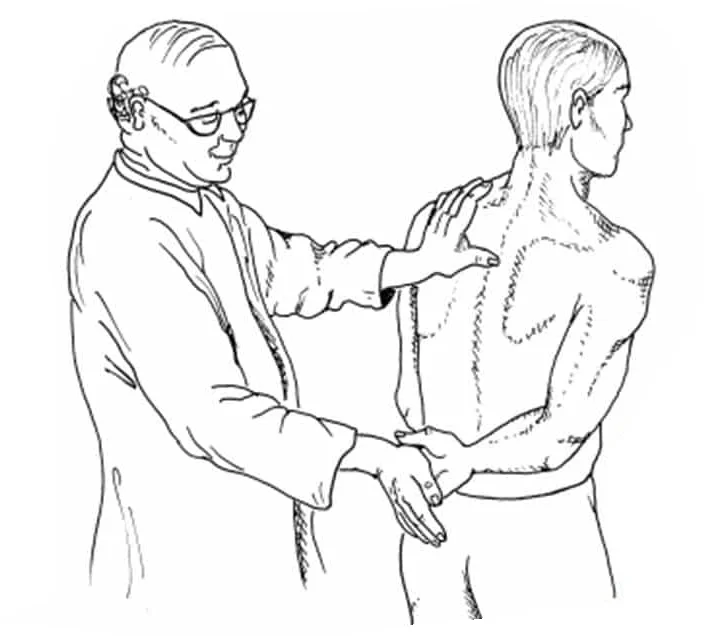
- How to administer the test:
- Arm position: The patient presses the upper part of the hand, or the back of the afflicted arm, on the mid-lumbar region of the lower back.
- Movement: The patient is told to lift their hand off their back by internally rotating their shoulder. Positive test result:
Positive test result:
- A positive test suggests possible malfunction of the subscapularis if:
- Lifting their hand off their back is impossible for the patient.
- The patient makes up for it by activating other muscles to help with the movement, including the rotator cuff or biceps.
Treatment for subscapularis pain
- The intensity and underlying cause of subscapularis muscle pain determine how it should be treated. The following are a few typical treatment choices:
- Rest: Be clear of activities that make the pain worse.
- Ice: You can lessen discomfort and inflammation by applying ice packs to the afflicted area for 15 to 20 minutes at a time, multiple times a day.
- Painkillers: Over-the-counter painkillers that can help manage inflammation and discomfort include ibuprofen and acetaminophen.
- Physical therapy: To increase shoulder range of motion, strengthen the subscapularis muscle, and regain function, a physical therapist might create a customized training regimen. Stretches, strengthening exercises, and activities that increase shoulder stability are examples of exercises.
Exercises for subscapularis pain
Pendulum exercise:
- Lean forward: Place your hand on a solid object for support while standing or sitting with your back straight and bending forward at the waist.
- Make a gentle circular motion with your afflicted arm to begin swinging. As you become more comfortable, progress to bigger circles from smaller ones.
- Transform: After a few minutes, turn the circles around.
- Next, try swinging your arm side to side or forward and backward when you’ve completed the circular motions.
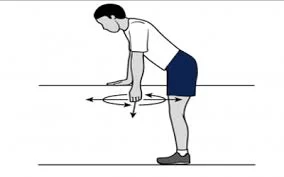
Table Slides:
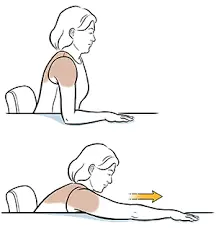
- How to: Place your afflicted arm on a table as you sit. Use your unaffected hand to move your affected arm in various directions, including up, down, forward, and backward.
- Advantages: Enhances abduction, adduction, flexion, and extension.
Wall Slides:

- Arms slide on the wall
- To do this, stand with your arms straight at your sides and your back to a wall. Slide your arms as high as you can up the wall slowly.
- Benefits include better abduction and flexion.
Internal Rotation with Stick
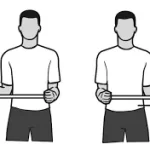
The exercise can be completed as follows:
- Locate an appropriate stick: A PVC pipe, broomstick, or mop handle can all be useful tools.
- stand straight.
- Pick up the stick. The stick should be held with one end in your affected hand and the other end in your unaffected hand.
- Lift: 90-degree elbow bend while raising your afflicted arm out to the side.
- Rotate your arm: Using the stick as leverage, rotate your arm toward your body. Your hand that isn’t injured will go to your head.
- hold: 15-30 seconds
- Repeat: Do this ten to fifteen times, or as your physical therapist advises.
Shoulder Flexion Exercise
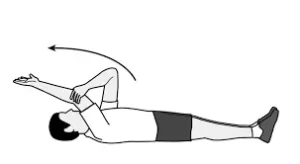
- Place yourself on your back on a level surface, either the floor or a yoga mat.
- Straighten your arms and raise them toward the ceiling, palms facing one another.
- Workout:
- Inhale: Lower your arms slowly to your sides while keeping them straight.
- As you release your breath, raise your arms back toward the sky.
Passive Internal Rotation
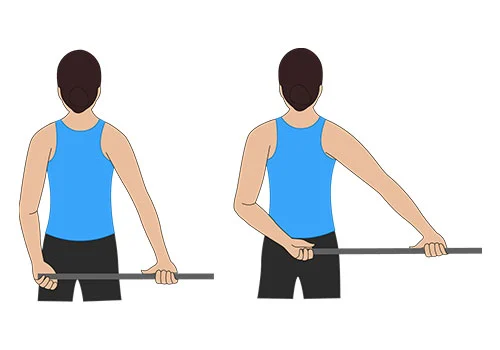
Position at Start:
- Take a tall stance with your feet shoulder-width apart.
- Hold a light stick behind your back, such as a dowel or broomstick.
- hold the stick as you can see in the picture.
- Motion:
- Pull the stick gently in a horizontal direction.
- The front of your shoulder should feel somewhat stretched. Hold For 15 to 30 seconds
- Continue on the opposite side.
Streches for subscapularis pain
Cross-body stretch:
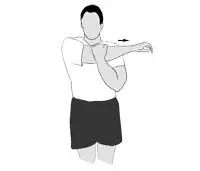
- This stretch focuses on the subscapularis muscle in the front of your shoulder.
- Holding your right arm with your left hand beneath the elbow, raise it over your chest.
- Pull your right arm gently toward your chest until you feel your right shoulder stretch.
- hold: 30 sec and repeat.
Doorway stretch:
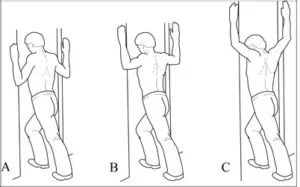
- Place your forearm and hand against the doorframe while standing in a doorway with one arm out at shoulder height. Make sure your upper arm is parallel to the floor.
- Lean: Take the opposing foot forward and slowly bend your body forward until your front shoulder starts to stretch.
- Internal Rotation: As you bend, turn your shoulder slightly inward, as though you were attempting to touch your back with your fingertips. This will further activate the subscapularis.
- Feel the front of your right shoulder extend as you lean forward a little.
- you can hold this for 20-30 sec
Towel stretch:
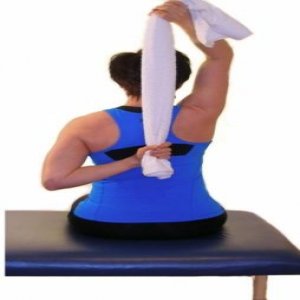
- The back of your shoulder is another area that this stretch works on. Tie a towel around your right hand and behind your back. Using your left hand, gently tug on the towel until you feel a stretch at the back of your right shoulder.
- 30 sec of hold and repeat.
Precautions:
- Activities that cause pain should be avoided. These include repetitive shoulder motions like swimming or tennis, as well as overhead activities like reaching for high shelves or tossing.
- By applying ice to the afflicted area, you can lessen discomfort and inflammation. ice application for 12 to 15 min.
- Over-the-counter pain relievers, such as Ibuprofen and naproxen, are two examples of non-steroidal anti-inflammatory medicines (NSAIDs) that can help lower pain and inflammation.
- Rest the injured shoulder by avoiding demanding activities and getting lots of sleep.
- Keep your posture straight: Poor posture may further strain the subscapularis muscle.
- Strengthen the surrounding muscles: The subscapularis muscle can be supported and shoulder stability can be increased by strengthening the muscles surrounding the shoulder, such as the rotator cuff muscles.
Complications
- Inadequate management or no treatment for subscapularis muscle pain can result in several problems, such as:
- Chronic pain: The discomfort could last for a long time and get in the way of everyday tasks.
- Range of motion loss: You may find it difficult to reach, lift, and rotate your arm because the shoulder joint may become tight and difficult to move.
- Weakness in the subscapularis muscle can further impair shoulder stability and raise the chance of injury.
- Tears in the rotator cuff: The subscapularis muscle stabilizes the shoulder joint. Tears in other rotator cuff muscles may be more likely if the subscapularis muscle is weak or damaged.
- Frozen shoulder: This syndrome, which causes extreme stiffness and discomfort in the shoulder joint, can occasionally develop as a result of untreated subscapularis pain.
FAQs
How is pain in the subscapularis treated?
The underlying cause and the intensity of your symptoms will determine how you are treated for subscapularis pain. Nonetheless, some typical therapies include:
Ice rest and physical rehabilitation
Painkillers
Injections
Surgery (in extreme situations)
How should someone who has subscapularis pain sleep?
The damaged shoulder won’t be compressed or forced into an uncomfortable posture when you lie on your back. Think about sleeping in a chair or on a wedge cushion during the first few days or weeks, when symptoms are at their worst. A person can prevent rolling onto their side or stomach while they sleep by sleeping on a modest inclination.
What are some ways to avoid subscapularis muscle pain?
Examples of preventive measures include regular exercise, safe lifting practices, avoiding overuse, maintaining proper posture, and performing strengthening and stretching activities.
When should I see a doctor if I have discomfort in my subscapularis?
See a physician if you experience weakness, limited range of motion, or persistent or worsening shoulder pain. Early diagnosis and treatment can maximize outcomes.



